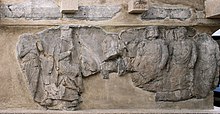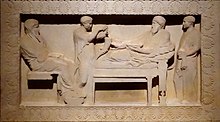Satrap

Asatrap(/ˈsætrəp/) was a governor of theprovincesof the ancientMedianandPersian (Achaemenid) Empiresand in several of their successors, such as in theSasanian Empireand theHellenisticempires.[2]Asatrapyis the territory governed by a satrap.[3]
A satrap served as aviceroyto the king, though with considerable autonomy. The word came to suggest tyranny or ostentatious splendour,[4][5]and its modern usage is apejorativeand refers to any subordinate or local ruler, usually with unfavourable connotations of corruption.[6]
Etymology[edit]
The wordsatrapis derived via LatinsatrapesfromGreeksatrápes(σατράπης), itself borrowed from anOld Iranian*khshathra-pa.[7]InOld Persian,which was the native language of the Achaemenids, it is recorded askhshathapavan(𐎧𐏁𐏂𐎱𐎠𐎺𐎠,literally "protector of the province" ). TheMedianform is reconstructed as*khshathrapavan-.[8]ItsSanskritcognate iskshatrapa(क्षत्रप).[9]TheBiblical Hebrewform isaḥashdarpanאֲחַשְׁדַּרְפָּן,as found in Esther 3:12.[10][11]
In theParthian(language of theArsacid Empire) andMiddle Persian(the language of theSassanian Empire), it is recorded in the formsšahrabandšasab,respectively.[12]
Inmodern Persianthe descendant of*khshathrapavanisshahrbān(شهربان), but the components have undergonesemantic shiftso the word now means "town keeper" (shahrشهرmeaning "town" +banبانmeaning "keeper" ).[citation needed]
History[edit]
This sectionneeds additional citations forverification.(May 2024) |
Medo-Persian[edit]


Although the first large-scale use of satrapies, or provinces, originates from the inception of theAchaemenid EmpireunderCyrus the Great,beginning at around 530BCE, provincial organization actually originated during theMedianera from at least 648BCE.
Up to the time of the conquest ofMediaby Cyrus the Great, emperors ruled the lands they conquered throughclient kingsand governors. The main difference was that in Persian culture the concept of kingship was indivisible from divinity: divine authority validated thedivine right of kings.The twenty-six satraps established by Cyrus were never kings, butviceroysruling in the king's name, although in political reality many took advantage of any opportunity to carve themselves an independent power base.Darius the Greatgave the satrapies a definitive organization, increased their number to thirty-six, and fixed their annual tribute (Behistun inscription).

The satrap was in charge of the land that he owned as an administrator, and found himself surrounded by an all-but-royal court; he collected the taxes, controlled the local officials and the subject tribes and cities, and was the supreme judge of the province before whose "chair" (Nehemiah3:7) every civil and criminal case could be brought. He was responsible for the safety of the roads (cf.Xenophon), and had to put down brigands and rebels.
He was assisted by a council of Persians, to which also provincials were admitted and which was controlled by a royal secretary and emissaries of the king, especially the "eye of the king", who made an annual inspection and exercised permanent control.

There were further checks on the power of each satrap: besides his secretarial scribe, his chief financial official (Old Persianganzabara) and the general in charge of the regular army of his province and of the fortresses were independent of him and periodically reported directly to theshah,in person. The satrap was allowed to have troops in his own service.
The great satrapies (provinces) were often divided into smaller districts, the governors of which were also called satraps and (by Greco-Roman authors) also calledhyparchs(actuallyHyparkhosin Greek, 'vice-regents').[14]The distribution of the great satrapies was changed repeatedly, and often two of them were given to the same man.

As the provinces were the result of consecutive conquests (the homeland had a special status, exempt from provincial tribute), both primary and sub-satrapies were often defined by former states and/or ethno-religious identity. One of the keys to the Achaemenid success was their open attitude to the culture and religion of the conquered people, so the Persian culture was the one most affected as the Great King endeavoured to meld elements from all his subjects into a new imperial style, especially at his capital,Persepolis.

Whenever central authority in the empire weakened, the satrap often enjoyed practical independence, especially as it became customary to appoint him also as general-in-chief of the army district, contrary to the original rule. "When his office became hereditary, the threat to the central authority could not be ignored" (Olmstead). Rebellions of satraps became frequent from the middle of the 5thcentury BCE.Darius Istruggled with widespread rebellions in the satrapies, and underArtaxerxes IIoccasionally the greater parts ofAsia Minorand Syria were in open rebellion (Revolt of the Satraps).
The last great rebellions were put down byArtaxerxes III.
Seleucid[edit]


The satrapic administration and title were retained—even for Greco-Macedonian incumbents—byAlexander the Great,who conquered the Achaemenid Empire, and by his successors, theDiadochi(and their dynasties) who carved it up, especially in theSeleucid Empire,where the satrap generally was designated asstrategos(in other words, military generals); but their provinces were much smaller than under the Persians. They would ultimately be replaced by conquering empires, especially theParthians.
Parthian and Sassanian[edit]
In theParthian Empire,the king's power rested on the support of noble families, who ruled large estates and supplied soldiers and tribute to the king. City-states within the empire enjoyed a degree of self-government, and paid tribute to the king. Administration of theSassanid Empirewas considerably more centralized than that of the Parthian Empire; the semi-independent kingdoms and self-governing city states of the Parthian Empire were replaced with a system of "royal cities" which served as the seats of centrally appointed governors calledshahrabsas well as the location of military garrisons.Shahrabsruled both the city and the surrounding rural districts. Exceptionally, theByzantine Empirealso adopted the title "satrap" for the semi-autonomous princes that governed one of itsArmenian provinces,theSatrapiae.
Indian[edit]

The Western Satraps or Kshatrapas (35–405 CE) of theIndian subcontinentwereSakarulers in the western and central part of theSindhregion ofPakistan,and theSaurashtraandMalwaregions of westernIndia.They were contemporaneous with theKushans,who ruled the northern part of the subcontinent from the area ofPeshawarand were possibly their overlords, and with theSatavahana,who ruled in central India to their south and east and theKushanstate to their immediate west.
See also[edit]
References[edit]
- ^Cahn, Herbert A.; Gerin, Dominique (1988). "Themistocles at Magnesia".The Numismatic Chronicle.148:13–20.JSTOR42668124.
- ^"Satrap".Free Merriam-Webster Dictionary.Merriam-Webster.Retrieved26 January2012.
- ^"satrapy".Wiktionary.org.Retrieved14 August2020.
- ^"satrap".Oxford English Dictionary.
- ^Trollope, Anthony (12 May 2011).The Eustace Diamonds.Oxford: Oxford University Press. p. 626.ISBN978-0-19-162041-6.Retrieved28 November2020.
- ^Butterfield, Jeremy, ed. (2015). "satrap".Fowler's Dictionary of Modern English Usage(4 ed.). Oxford University Press. p. 724.ISBN978-0-19-966135-0.
- ^"Greece xii. Persian Loanwords and Names in Greek".Encyclopædia Iranica.2012.Archivedfrom the original on 25 February 2024.Retrieved25 February2024.
- ^Bukharin, Mikhail."[Towards the Discussion on the Language of the Scythians: The Transition of OIr *xš- > *s- and its Reflection in the Ancient Greek] К дискуссии о языке скифов: переход др.ир. *xš- > *s- и его отражение в древнегреческом".Проблемы Истории, Филологии, Культуры. 2013. 2. В честь 60-летия В.Д. Кузнецова. С. 263–285.
- ^"Kshatrapa, Kṣatrapa, Kshatra-pa: 8 definitions".Wisdom Library.
- ^Esther 3:12The Bible (Jewish Publication Society, 1917)
- ^'ăḥašdarpᵊnîm (H323)inStrong's Concordance
- ^MacKenzie, David Neil(1971). "šasab".A Concise Pahlavi Dictionary.
- ^André-Salvini, Béatrice (2005).Forgotten Empire: The World of Ancient Persia.University of California Press. p. 46.ISBN978-0-520-24731-4.
- ^Tuplin, Christopher,"The Administration of the Achaemenid Empire".In I. Carradice (ed.),Coinage and Administration in the Athenian and Persian Empires(1987; Oxford: BAR), 109-166.
- ^Mørkholm, Otto (1991).Early Hellenistic Coinage: From the Accession of Alexander to the Peace of Apamea.Cambridge University Press. p. 73f.
- ^Curtis, John; Tallis, Nigel; André-Salvini, Béatrice (2005).Forgotten Empire: The World of Ancient Persia.pp. 258–59, fig. 454, Silver tetradrachm of Bagadates.
Further reading[edit]
- Ashley, James R. (2004) [First published 1998]."Appendix H: Kings and Satraps".The Macedonian Empire: The Era of Warfare Under Philip II and Alexander the Great, 359–323 B.C.Jefferson, NC: McFarland. pp. 385–391.ISBN978-0-7864-1918-0.
- Jacobs, Bruno (1994).Die Satrapienverwaltung im Perserreich zur Zeit Darius’ III.Tübinger Atlas des Vorderen Orients, Beihefte, vol. B 87. Wiesbaden: Reichert,ISBN3-88226-818-2.
- Klinkott, Hilmar (2000).Die Satrapienregister der Alexander- und Diadochenzeit.HistoriaEinzelschriften, vol. 145. Stuttgart: Franz Steiner,ISBN3-515-07701-4.
- Klinkott, Hilmar (2005).Der Satrap. Ein achaimenidischer Amtsträger und seine Handlungsspielräume.Oikumene. Studien zur antiken Weltgeschichte, vol. 1. Frankfurt: Verlag Antike,ISBN3-938032-02-2
- A. T. Olmstead,History of the Persian Empire,1948.
- Pauly-Wissowa (comprehensive encyclopaedia on Antiquity; in German).
- Petit, Thierry (1990).Satrapes et Satrapies dans l’empire achéménide de Cyrus le Grand à Xerxès Ier.Bibliothèque de la Faculté de Philosophie et Lettres de l’Université de Liège, vol. 254. Genève: Droz,ISBN2-251-66254-5.
- Robert Dick Wilson.The Book of Daniel: A Discussion of the Historical Questions,1917. Available on home.earthlink.net.
- Rüdiger Schmitt, "Der Titel 'Satrap'",inStudies Palmered. Meid (1976), 373–390.
- This article incorporates text from a publication now in thepublic domain:Chisholm, Hugh,ed. (1911). "Satrap".Encyclopædia Britannica(11th ed.). Cambridge University Press..


